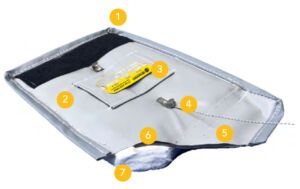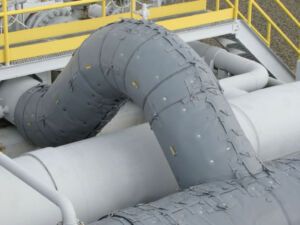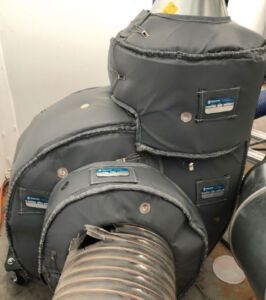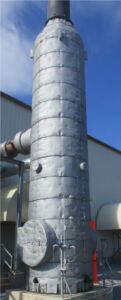Acoustic blanket insulation can lower noise levels on equipment by capturing sound energy through sound reflection and absorption. The combination of sound reflection and absorption is the key to blanket insulation noise reduction. Each application is slightly different in complexity. But the general rule for blanket insulation is a reduction of 4 to 15 dBA; that’s an overall reduction (anti log summation calculation). Often reduction targets address peak frequency shaving to accommodate the problem, in other cases, overall reduction across the spectrum is necessary.
Field testing to validate the immediate problem is the best approach. By measuring sound pressure levels, benchmarked against ambient conditions, we can clarify the problem and the solution. For HVAC equipment, the ANSI-ARI-575 test method defines a perimeter measure with center-point octave band measurements. A-weighted-decibel, or dBA, averaging of these perimeter measurements and scaling the center-point octaves provides a map of the sound/noise challenge. Lab testing on specific blanket designs will also help benchmark performance, using ASTM-E1222, defining insertion loss performance in both linear and A-weighted measures. Testing is the key when defining specific acoustic blanket solutions. Shannon offers a wide range of cost-effective solutions.
Some attributes of blanket insulation that allow for a high probability of success when applying acoustic blanket insulation to mechanical equipment are:
Flexibility, which allows a shaping and bending of material to match complex surface conditions. Equipment surface complexity is common and treating these surfaces is challenging at best when applying conventional insulation materials. By using an insulation which bends, shapes, and configures to the surface, facility owners gain a huge advantage. Because the materials are flexible, they also resist vibration. Since noise represents simple harmonic motion, vibration is sound and vice versa.
Self-contained which lends itself well to the condition of access, for service, inspection, and repair. Self-contained means the insulation/septum materials are encapsulated in a protective jacketing and either double-sewn and binded, or, in the case of high temperature blankets, jacketed using stainless steel wire mesh. The jacketing materials are stapled using monel, rustproof staples.
Ease of Access. If access to the equipment is necessary, blanket systems save the owner money on removal, installation, and labor because operators can remove the blankets within minutes and re-install them just as quickly. The compelling cost savings and instant access gives the operator owner better efficiencies to gain access to critical surfaces. Self-contained also means the “blanket system” includes all the necessary components (i.e., jacketing, insulation core, reflective septum, tagging, integral fasteners). With a self-contained system, the operator doesn’t require tools or materials to remove or re-install.
CAD/CNC technology enhances and improves the quality of both fit/accuracy and construction. CAD allows for accurate geometric matching to irregular surface conditions. CAD produces the absolute best fit. So once a geometric design is created and validated for fit, CAD allows the reuse of that design. Applying CNC technology in manufacturing improves geometric tolerances and the accuracy of design and assembly. Materials are cut to a 1/32” accuracy, providing high probabilities of quality assembly.
Surface mass dictates noise reduction. And the balance between thickness and surface mass is the recipe for success. Choosing the right blanket design—including thickness, finished surface mass and where the treatment is critically applied—is the strategy that makes acoustic blanket insulation successfully insulate and lower noise levels on equipment.
DESIGN FEATURES
- Double Sewn and Binded Seams
- Durable PTFE Teflon® Impregnated Fiberglass Cloth
- Aluminum Nameplate Embossed Lettering With Tag Description
- Stainless Steel Lacing Hardware With Featured Wiretwist Fastener
- Extended Velcro® Flap on Closing Seams High Density Mass Loaded Vinyl (Reflection)
- High Density Needled Fiberglass Mat Filler (Absorption)
Considerations when selecting the correct blanket system includes:
- Temperature (Ambient to 2000F)
- Noise Profile (Octave Band Scaling and Harmonics)
- Overall Sound Pressure or Sound Power (dBA Average)
- Identification of Sound Sources (Hot Spots, Specific Components)
Shannon GES provides a complete offering of blanket insulation solutions from ambient temperature to 2000 F as well as designs for HVAC commercial mechanical equipment and extreme industrial conditions. As a result, the array of solutions and applications is large.
Common Applications Include:
- Pressure Reducing Valves, Control Valves
- Process Piping & Fittings
- Compressors (Scroll, Screw, Centrifugal, Single Stage, Multistage)
- Interstage Piping and Interstage Coolers (Heat Exchangers)
- Condenser Shells, After Coolers, Economizers
- Liquid Chillers
- Pumps
- Fan / Blower Housings
- Ducting
- Silencers / Mufflers
For guidance to lower noise levels on equipment, visit our specifications and applications at:
Acoustic Blanket Insulation and Shields – Shannon Global Energy Solutions





